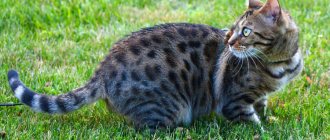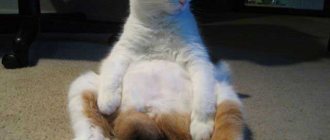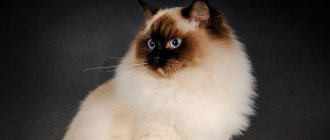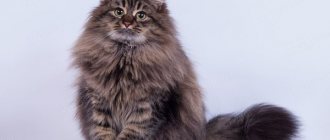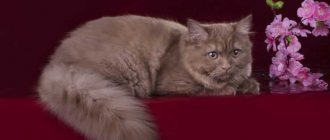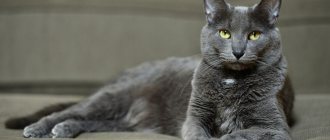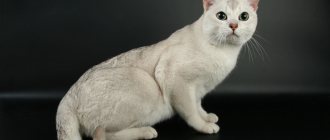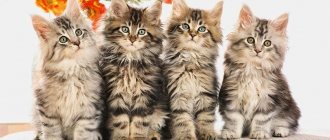Rex
The main distinguishing feature of Rex cats is their wavy fur. This feature appeared due to natural genetic mutations and was fixed through selection.
Varieties and appearance
There are three main types of rex.
Cornish Rex
Originally from England, Cornwall. The head is small, with pronounced cheekbones. The body is graceful, flexible, the limbs are long and slender. The guard hairs are very thin, the same length as the undercoat. Both types of fur curl in one direction, towards the skin.
Cornish Rex cats are particularly flexible and elegant.
Devon rex
The first individuals also appeared in England, in the county of Devonshire. The head is short and wide, with a strong chin. The body is muscular, with a broad chest. There is no outer coat, the guard hairs are longer and thicker than the undercoat. The waves of these types of wool are directed in different directions.
Cornish and Devonian are recognized by all major felinological organizations.
The Devon Rex's fur and undercoat are curled in different directions.
German rexes
The first animals were discovered in eastern Prussia. The head is rounded, with a pronounced chin and cheeks. The body is strong and strong, but not massive. Legs are thin, of medium length. The structure of the coat corresponds to the type of Cornish Rex.
German Rexes are recognized by FIFe, WCF and SCFF. The CFA is currently refusing to register them due to their being too similar to English types.
German rexes are strong and robust animals.
In addition to the main branches, there are two more young but promising rex breeds.
Selkirk Rex
A breed of American selection. The head is round and wide, with pronounced cheeks. Persian cats were used in breeding work, so the muzzle is slightly shortened. The body is rectangular, muscular, with strong bones.
The coat is thick, without topcoat, with large waves. Can be short or long. As a rule, kittens are born very curly. At about 2 months, the coat straightens, and starting from 8–10 months, it curls again.
The breed is recognized by ACF, WCF, CFA, TICA, ACFA.
The American variety of Rex quickly gained popularity
Ural rex
The first mentions of this aboriginal breed date back to the 40s. last century, but thorough breeding work began only in 1992.
The head is shaped like a short, wide wedge with pronounced cheekbones. The body is muscular, yet slender. The coat is of medium length, with very little outer hair. The curls are clear, without a specific direction.
Among the international organizations, the breed was recognized by the WCF.
The Ural Rex is an indigenous breed that has only recently attracted the attention of breeders
In addition, there are other, less common breeds of cats with wavy hair: Oregon, Tennessee, Missouri Rex, etc. Some of them are now in their infancy, others, having existed for some time, “dissolved” in the main branches or disappeared after cessation of breeding work.
Character
All rexes are famous for their friendliness and affection. These are pronounced companions who strive for human society and have a hard time enduring loneliness. Quite patient with children.
They strive for physical contact, and Cornish and Devonians prefer to sit not on a person’s lap, but on a person’s shoulders.
In childhood they are very active. With age, activity becomes more moderate, but rarely turns into laziness. They love heights and often climb to the highest points in the house.
Before purchasing such an animal, you need to take into account that many rexes are very “talkative” and often meow.
They are inquisitive, intelligent and can learn a number of commands and tricks. Some wear aport on their own initiative. Most quickly learn the rules of behavior in the house, although some can be headstrong.
German rexes especially quickly get used to the daily routine and often begin to wait for their owner at the door in advance. They are characterized by special neatness: according to reviews, many of them treat their toys very carefully and, after frolicking, independently take them to a secluded place.
Many rexes are sensitive to the mood of their owner and even try to console him if he is upset.
On the plus side, Devons are very affectionate and follow a person with their tail. And they are also very talkative, and not just Meow, but also MEAYAYA, Myak (short) or MEYak, my favorite sound is Ek (surprisingly short). You come home tired from work and Niba - say Ek! ...Eck! And it feels so good right away. When you eat, he unceremoniously climbs into your arms, and when you are just sitting somewhere, he will sit opposite you and Meow until you pat your knees and say “Niba, come here,” he runs, jumps up and sleeps. She can accompany the whole evening with her voice. I was cooking recently, and she was sitting opposite me - she opened her mouth and so on with an aspirated “K”. While I was cutting the salad, I started counting these “K”s 37 times without a break)
zvezdafur
https://irecommend.ru/content/devon-dobav-bezumiya-v-svoyu-zhizn
Features of care
The soft coat of the main rex groups does not require complex care. It is combed with a natural brush once every two weeks. Shedding occurs almost unnoticed, but at this time the frequency of brushing increases to once a week.
Some breeders recommend wiping animals with chamois every day: this helps maintain the shine of the coat and “keep the curl.”
Rexes are bathed approximately once every two months using mild shampoos for short-haired breeds. You cannot use a hairdryer for drying - due to hot air, the wool becomes brittle and loses its shine.
It is important not to overfeed the animal - due to their accelerated metabolism, rexes love to eat and often beg for more. There should be no poisonous plants in the house so that the pet does not get poisoned by tasting them.
Nails are trimmed about twice a month.
Photo gallery: rex
Rexes get bored alone, so you can get a companion for your pet
Baby rexes are very active
Rexes love to watch their owners and try to take part in all their affairs.
Rexes come in many colors
Female rexes are caring mothers
Raising an exotic cat
Exotic shorthair cats are highly intelligent and therefore easy to train. Raising pets begins from the first days of their appearance in the house. The main thing is to accustom the kitten to the tray and scratching post. As a rule, there are no problems with this, because smart exotics quickly remember the necessary rules of behavior.
A toilet with a comfortable filler is installed in a quiet place so that the baby can do his business without being distracted by external irritants. At first, you need to put him in the tray at the first signs of anxiety and sniffing the corners. It is worth holding the kitten there for several minutes, not forgetting to stroke it. This way he will not have a feeling of fear or hostility.
You can teach him to use a scratching post using a special solution from a pet store. It is simply sprayed onto the surface. You can use valerian tincture for these purposes.
Reviews from owners of exotic pets indicate that they are quite capable of following basic commands and also quickly learn prohibition words. They understand well the timbre of the voice or intonation of the owner. Therefore, you should not shout at the cat or raise your hand to it. Bullying will harm your pet's mental and physical health.
Laperm
The LaPerm is another breed with a wavy coat. Some classify it as a member of the rex group, others believe that there are important differences that allow it to be placed apart.
First of all, this is a dominant gene for curly hair - in the three main groups of rexes it is recessive. In this respect, Laperms are similar to the Selkirk Rex.
Laprems differ from Selkirks by having a longer snout.
The first kitten, which became the founder of the breed, was born in Dallas. Interestingly, the animal was initially bald, like a sphinx, but by two months it began to be covered with curly hair.
The name of the breed comes from the word “perm” - permanent wave.
At the moment, the breed is recognized by all major felinological organizations.
There is a dwarf variety of laperm - skukum.
Appearance
According to CFA standards, the head is shaped like a modified wedge, with full whisker pads. The ears are cupped, tassels are allowed. The eyes are almond-shaped.
Body of medium size, proportional. The average weight of females is 2-4 kg, males - 4-6 kg. The croup is slightly higher than the shoulders.
Any color is allowed. The coat can be semi-long or short.
The half-long one should be airy and loose, easily moving apart with breathing. Outwardly, she usually looks shaggy. Length and density may vary depending on the season.
The short coat is springy and soft, but slightly harsher than the half-long coat.
Laperms always look a little shaggy
Character
Laperm is a gentle and sociable animal. These cats often purr in the presence of their owners, even if they are not petted. Loneliness is extremely painful to bear.
They love to sit on hands, often reach out to a human face, and, if possible, try to touch it with their paws, lick it and “kiss” it.
Many representatives of this breed love to watch TV with their owner, and often do this with amusing emotionality.
They are quite active and need outdoor games. Travel easily.
Care
Brush the animal about once a week. It is important to carry out regular flea treatment - they often infect this particular breed.
Like rexes, laperms should not be dried with a hairdryer - it can straighten the fur. On the contrary, after drying, you can spray it with a little water so that the curls are better expressed.
Photo gallery: Laperm cats
Semi-longhaired Laperms have a pronounced collar
Laperms prefer to spend maximum time with their owners
Any color is allowed for laperms
1.American Wirehair cat
The rarest breed of domestic cat in the world is the American Wirehair. It is a medium-sized, muscular, robust animal with clear eyes, wide-set, round ears, fur of various colors and patterns, and a quiet voice. The breed arose as a result of a natural mutation of the American Shorthair cat. The first representative was born in 1966 in the litter of a farm cat in northern New York. The kitten has grown brown-white, hard, dense, elastic fur, different from the parent species. The fur was considered unique because the hairs in all layers were twisted, like thin wires, with curved ends. The character of the American Wirehair cat is identical to the American Shorthair: they are good-natured, observant, calm, but can remain playful throughout their lives. The gene that gives the coat a hard texture is not dominant in the offspring of the American Wirehair, so such kittens are born very rarely. In the early 2000s. There are only 22 cats registered in the world, and the number has not increased significantly since then.
Related Posts
Top 10 rarest dog breeds
Top 10 Most Beautiful Cat Breeds in the World The Largest Wild Cats
Sphinxes
Hairless cats appeared relatively recently, but managed to gain enormous popularity.
Main breeds
There are several breeds of Sphynx.
Canadian
The oldest variety. The first representative was the kitten Prune, born in Toronto. Subsequently, most of the breeding work took place in the USA and Holland. The breed is recognized by all major felinological organizations.
The head is slightly longer than wide. The ears are large, the muzzle has pronounced cheekbones and a strong chin.
The body is muscular, heavy, with a convex belly. Legs are strong. Short hair is allowed on the paws, tail, ears, and scrotum. The rest of the body may be completely bald or covered with down of no more than 2 mm.
Canadian Sphynxes appeared as a result of a random mutation
Based on this breed, a number of hybrids have been bred, for example, elves - hairless cats with curled ears.
Don
The breed comes from Rostov-on-Don. Its ancestor was the cat Varvara, who was picked up on the street.
The breed is recognized by the WCF.
The head is wedge-shaped, the cheekbones and eyebrows are sharply defined. The ears are large. The body is strong, with a deep groin line.
Donchak dogs can be completely hairless or with coat types such as:
- flock - hairs are almost invisible in appearance;
- velor - hairs 2–3 mm;
- brush - relatively long and stiff wool.
The latter type is used for breeding and participates in exhibitions, but without the right to receive titles.
Completely hairless Don Chaks are considered the most striking and valuable representatives of the breed.
Peterbalds
Breeders purposefully created this breed by crossing the Don Sphynx and an Oriental cat. In further work, animals of the Siamese-Oriental group were also used.
The breed is recognized by CFF, TICA and WCF.
The head is wedge-shaped, narrow. The ears are large, the tips are spread apart. The eyes are almond-shaped. The physique is oriental: the body is elongated, flexible and thin, the limbs are long and slender. The coat types are the same as those of the Don Sphynski.
Peterbalds adopted the leanness and grace from their oriental ancestors
Character
Sphynxes are good-natured and affectionate pets that are extremely in need of human society. They prefer to spend as much time as possible with the owner, while actively trying to participate in his affairs, which is why they can be intrusive. Loneliness is very difficult to tolerate.
At the same time, they never curry favor with people, preferring equality. They are inquisitive and smart, capable of funny tricks and pranks. They are trained to walk on a leash. They are very active in childhood. They are not vindictive and patient with children. They get along peacefully with other non-aggressive animals. They can be quite talkative. This is especially often said about Peterbalds, who inherited this trait from their “eastern” ancestors. May be unclean when going to the toilet.
Of all the Sphynx breeds, I liked the Canadian Sphynx the most in appearance and character. […] After only half an hour of being in our family, the little mischief immediately made it clear that not a single thing in the house could be done without her: bills, drawers, cabinets, bags, a manicure lamp, tools - all new items that happen to be nearby are a must must go through strict control of Blueberries! She is very curious.
timofeeva_natalia
https://irecommend.ru/content/pro-nashego-druga-i-chlena-semi-kanadtsa-cherniku-mnogo-teksta-pro-zavodchikov-povedenie-kha
Care
The skin of Sphynx cats produces a specific brown “sweat”, so they need to be bathed about twice a month. In addition, the animal is regularly wiped with veterinary wipes.
It is important that the house is warm. Sphynxes love to bask in the sun, and in the heat they can get sunburned or get heatstroke. Dry air, feeding errors and a number of other factors lead to flaking of the skin. In this case, the pet can be lubricated with baby oil. You cannot indulge the immoderate appetite of these animals.
Video: features of caring for sphinxes
Likoy
If there was a competition for the most shocking cat breed, Likoi would definitely be among the leaders. “Likoi” in Greek means wolf, and I must admit that the name was chosen very well.
The build and size of these cats are the most common, average. But the coat is impressive: there is very sparse hair on the legs and belly - some Lykoi have almost none, the muzzle is almost bald. The color is also unique and is not found in representatives of other breeds: black and white hairs grow mixed, which is why the Lykoi’s fur coat is strikingly similar to a wolf’s skin. But the character of the Lykoi is the most cat-like: sociable, curious and playful.
Of course, Lykoi was bred from a random mutation discovered in the United States in unrelated outbred cats in 2010 and 2011. Enthusiasts became interested in strange cats and set about breeding a new breed. Numerous genetic tests have confirmed the safety of the mutation for cat health, and already in 2016 it was recognized by the American felinological system TICA.
Munchkin
The main feature of these cats is their short legs. The first representative of the breed was the Blackberry stray cat, which was found in 1983 in the USA.
The breed is recognized by TICA and WCF.
CFA and GCCF refuse registration because they consider short legs to be a defect that reduces the quality of life of the animal.
Appearance
The head is shaped like a modified wedge, slightly rounded. The cheekbones are high and may be more noticeable in males. The ears are wide at the base, set high and wide. The eyes are almond-shaped.
The body is long, with a rounded chest and firm hips. The tail is equal to the length of the body and should be raised up when moving. The weight of an adult animal is 2–4.5 kg. The legs are short, about 13 cm.
The coat is allowed to be short or semi-long. In the second case, the animal may have tufts on its ears.
Short legs give munchkins a weasel-like appearance.
Character
Munchkins are cheerful, active and friendly pets. They love human society, but do not depend on it and tolerate loneliness well.
As a rule, they treat children and strangers peacefully.
They are very curious, love to explore unfamiliar places and new objects. They tolerate walking on a leash and long trips with their owners well.
One of the most curious features of the breed is that when a munchkin is surprised or interested in something, it stands on its hind legs, pressing its front legs to its chest and leaning on its tail. A cat can stand like this for a relatively long time.
For many owners, the munchkins' way of standing on their hind legs seems no less exotic than their short limbs.
Despite their short legs, munchkins move quickly, confidently and gracefully, and stomp quite loudly. The manner of movement is somewhat similar to that of ferrets or mongooses. They love active games, although they do not jump as high as other cats.
According to a number of reviews, munchkins tend to “borrow” and hide things they like in secluded places.
If a munchkin doesn’t have a cat’s house or is not happy with it in some way, the animal will try to build a home from “survival materials.”
Very intelligent cats, they know how to think, analyze, draw conclusions, they learn everything so quickly, even what they shouldn’t (for example, how to open drawers and doors). For comparison: I also have a noble cat, their thinking is quite different. If I throw a toy and it flies behind the sofa, the cat will jump on the back of the sofa and look where it fell. The cat will not climb onto the sofa, he will assess the situation and immediately crawl under the sofa, guessing that the toy is already there. If I point my finger in the corner and say that the toy is there, the cat will come up to me and look at the finger, the cat will go where I point.
Ainnka
https://irecommend.ru/content/manchkiny-lyubov-odnazhdy-lyubov-navsegda
Care
Short-haired individuals are combed once a week, semi-long-haired individuals - 2-3 times. The animal is bathed approximately once every 3 months.
Munchkins are prone to tartar formation, so they need to brush their teeth at least once a week.
Video: Munchkin - all about the breed
5.Havana
The Havana is a striking cat with a luxurious dark brown or lilac coat, highlighted by light green oval eyes. Distinctive features are large rounded ears, slightly tilted forward, and a wedge-shaped head. Animals weigh from 2.5 to 4.5 kg. The breed was developed in the 1950s. in England with the help of the Siamese and the Black Shorthair and was recognized by the Cat Fanciers' Association in 1958 as the Chestnut Shorthair, but the name was changed to Havana in 1970. In the 1950s. Havanas were imported to the United States to create the new Havana Brown breed. Havana is inquisitive, mischievous, smart, and easily adapts to different situations. He is playful and sociable, needs attention and returns it with great love. Until the 1990s. There were only 130 individuals of Havana in the world, then the number increased slightly.
Manx
The main feature of these cats is the absence of a tail.
The breed was formed mainly in the wild, on the Isles of Man (Great Britain). According to legend, the ancestors of Manx cats were former sailor cats who survived shipwrecks. The tailless gene, which appeared due to a random mutation, soon became dominant in this peculiar community, and gradually the trait began to be passed on to all kittens.
After some time, animals began to be imported to Europe. The first breed standard was published already in 1903. Now Manxes are recognized by all major felinological organizations.
Manx cat formed in the wild
Appearance
The head is round, wide, with prominent cheekbones. The eyes are large and slanted. The ears are large, with rounded tips. The neck is strong and short.
The body is square, the croup is round. The hind limbs are longer. Paws are rounded. Weight ranges from 3.5 to 5.5 kg.
Tail Types:
- Dimple rumpy or rumpy - the caudal vertebrae are missing, in their place you can feel a fossa;
- Riser or rumpy riser - vertebrae hidden under fur;
- Stumpy - 1–3 visible vertebrae;
- Tailed or longy is a regular tail.
The wool is plush to the touch.
One of the characteristic features of this breed is the roundness of all shapes.
Character
Manxes are cats of one owner, and they choose him at their own discretion. The attitude towards the rest of the household is friendly, but rather restrained.
According to reviews, many Manx cats define their “rank” in the family as second after the main owner.
They are active and playful and jump very high. They often bring abandoned toys on their own initiative. They love to look at the water and play with the streams from the tap, but not to swim.
They get along well with dogs and other cats, but if necessary they can defend their interests quite harshly.
You should not allow access to small animals - Manx are excellent hunters.
My relatives got Manx. They first became acquainted with his agility when the kitten jumped without a run onto the lid of a rather high-standing aquarium. The glass underneath him slid sideways, and he himself ended up in the water, so there was quite a commotion. Since then, the aquarium has been covered with a special plastic lid, and all fragile items have been removed from the shelves. Not in vain - with age, this cat learned to take a height almost as tall as a man.
Care
Manx cats are brushed once a week, and during the molting period - every 1-2 days.
The breed is susceptible to tartar formation, so teeth should be brushed at least once a week, if possible more often.
Photo gallery: Menk cats
Animals with a complete absence of tails are rated highest at shows.
Manx cats benefit from walks in the fresh air.
Manx cats have a well-developed hunting instinct.
Manx are strong and resilient animals.
Although the average weight of Manx is relatively small, they look very massive
No tail
Some representatives of the cat family have another anomaly - the absence of a tail. Some have preserved some of their vertebrae, while others are completely missing. This is another natural mutation, and not an attempt to create a breed artificially. These cats are called Manx.
Manx
Interesting! According to legend, a tailless cat sailed on a ship that crashed near the island. The fluffy sailor made it to land and gradually began to meet kittens on the island that had no tails.
Another breed does not have the usual tail, but several vertebrae are preserved, thanks to which it still has a short tail. These are bobtails. If a standard tail has about 23 vertebrae, then in the case of a bobtail there are no more than 7.
This unusual breed also has other talents - they can not only meow or purr, but also emit something similar to barking and chirping. Kurilian bobtails are cats that are unable to retract their claws, which makes them similar to cheetahs.
Kurilian Bobtail
Bobtails
Also a short-tailed group of cats. As a rule, bobtails are distinguished by their large size and dense, wet-resistant coat.
Tails can be of the following forms:
- Stump. From 2 to 5 cm. There are breaks at an obtuse angle.
- Spiral. The apparent length is 5–10 cm. There are numerous fractures, often at sharp angles.
- Retracted bobtail. Near the base the tail is normal, after 5–7 vertebrae kinks begin.
- Panicle. Length from 5 to 15 cm, breaks at right angles.
Bobtail breeds
There are several breeds of bobtails.
American
The head is wedge-shaped. The body is moderately long, the back is straight. Weight 3–8 kg. The coat can be short or semi-long.
Yankeebobs with semi-long hair should have a collar
Japanese
The head is triangular. Individuals with eyes of different colors are often found. The body is oblong, muscular, but not massive. Weight 3.5–5 kg. The coat is short.
In Japan, this cat symbolizes friendship, in Korea and China - well-being.
Kuril
The head is in the shape of an equilateral triangle. The body is strong and muscular. Weight 3–7 kg. The coat is semi-long and thick. There may be tufts on the ears, making the animal look very much like a lynx.
Thick, warm fur helped Kurilian Bobtails survive in the wild
Mekong
The head is rounded. The body is rectangular in shape, but quite slender. The only colors allowed are Siamese. Weight 2.5–5 kg.
According to legend, these animals accompanied the princesses, and while they were bathing, they strung jewelry onto the cats' broken tails.
Karelian
The head is triangular, the muzzle is narrow. The body is strong, the hind legs are noticeably longer. The coat can be short or semi-long.
Karelian Bobtail is the rarest variety
Character
Bobtails are conspicuous companions. They love to spend time in human society and are painfully sensitive to loneliness.
The most independent bobtails are the Mekong.
Most of these animals are very active and love outdoor games. They are smart and often have developed logical thinking. Most often they respond well to training. Usually travel easily.
As a rule, they get along peacefully with cats and dogs. Most of all, the “Japanese” love the company of other animals, and they prefer to be friends with representatives of their own breed.
The hunting instinct is pronounced. Many bobtails are excellent rat catchers, and some - for example, Kuril and Japanese - can fish.
Most are quite sociable, often making rich intonation sounds similar to chirping or abrupt yelps, but not to a regular meow.
The quietest and calmest of bobtails are Karelian. If such a cat needs something from its owner, he would rather touch it with his paw than meow.
Moti's character is simply unique. It’s not for nothing that kurbob is called cotops. He chose me as his owner, and it's obvious. He only sits in my arms and follows me around the house. My husband says that he even feels when I should come - he runs to the door. And when I’m not home for a couple of days, the cat... howls. Drawingly, long, like a dog. Despite the fact that both his husband and mother feed him, he keeps them at a distance. Bored, my red “Hachiko” curls up on some of my clothes. I even specially leave him some old things if I’m away for a long time, as an “anti-stress.”
Martovskaya
https://irecommend.ru/content/ne-pakhnet-i-ne-metit-ili-antikvar-v-koshachei-shkure-zabavnye-foto
Care
Short-haired bobtails are usually brushed once a week, while semi-long-haired ones are brushed once every 2-3 days. During the molting period, this is done daily. If necessary, you can bathe the animal approximately once every 2 months.
Video: Kurilian Bobtail - all the details about the breed
Elf
The Elf cat is a new and extremely rare hybrid species that arose as a result of crossing the Sphynx with the American Curl. She inherited the lack of fur, wrinkled skin, athletic muscular body, long tapering tail from the Sphynx and curled back ears from the American Curl. Elf cats come in all colors and patterns. Although the breed is considered hairless, short, fine hair may grow on the legs, ears, nose, and tail. Elves weigh from 4 to 7 kg. They are smart, friendly, sociable, affectionate. They are also very playful, mischievous, and adapt to any situation in the house. The breed was bred by breeders from the USA in 2006, but has not yet been registered with the International Cat Association. At exhibitions she is shown as a sphinx with special features. There are no more than 50 elves in the entire world.
Savannah
This young breed is the result of crossing wild servals and domestic cats. The first viable kitten was born in 1986.
At the moment, savanna is only recognized by TICA. Other organizations refuse registration due to the lack of stable characteristics in the breed.
Appearance
These are large animals, with a body and tail up to 135 cm in length. Weight from 7 to 15 kg.
The head is wedge-shaped, relatively small. The whisker pads are weakly expressed. The nose is wide. The ears are large, very wide at the base.
The body is elongated, with a strong chest, strong shoulders and hips. The limbs are long, the groin line is lean.
The coat is short and thick, with leopard spots.
The F1 generation, that is, obtained directly from the mating of a wild and domestic animal, has the most striking characteristics of the breed. Males from these matings are sterile until the 4th–5th generation, so females are mated with domestic cats, and the signs of wild blood gradually fade.
F1 generation cats are most similar to wild animals
Character
With proper upbringing, it is an intelligent and obedient pet. He gets attached to people, loves to spend time with them and may even wait near the door when he gets home from work. At the same time, he calmly endures loneliness.
Representatives of the breed are distinguished by curiosity, courage and mobility. They need plenty of space to play, otherwise the behavior can become destructive.
Savannah needs room to play
Savannah usually gets along well with other cats and dogs, and prefers to be friends with the latter if they recognize her as their “leader”.
These cats love water and, if possible, willingly swim in pools and ponds. They love to throw toys into a full bath and then catch them with their paws.
They jump up to 2.5–3 m in height, so it is not advisable to keep fragile things on the top shelves.
In an animal of the F1 generation, after the age of three, wild character traits may intensify. It is strictly not recommended for families with children to have such a cat.
Care
The animal should have enough space to burn off its energy, ideally an enclosure with a mini-pool attached to the house. In addition, it is advisable to walk, like for a dog, for 1–2 hours.
The coat is combed once a week.
Savannah does not tolerate cold well, so in winter you need to take care of insulating your house.
Video: origin and description of the Savannah cat breed
Exotic cat health
Possible diseases
Exotics are a human-bred breed, that is, they have not undergone natural selection. They are characterized by the same genetic diseases as their closest relatives - Persian cats. Therefore, the health of an exotic cat must be controlled by the owner.
The characteristic structure of the muzzle causes problems associated with disturbances in the shape of the nasolacrimal duct. This provokes diseases of the eyes and respiratory system. Pets often suffer from a runny nose due to hypothermia and exposure to drafts. Inflammation of the lacrimal glands leads to the development of conjunctivitis, and in the future it worsens exotic vision.
The oral cavity and teeth are also susceptible to the development of infectious diseases. The most common are gingivitis, stomatitis, and periodontal disease. This can be avoided if you carefully take care of the health of your cat's teeth and gums. Some animals experience abnormal development of the lower jaw. This pathology causes difficulty eating.
Unbalanced nutrition and overfeeding lead to the development of obesity in the pet. Problems with excessive weight provoke disturbances in the functioning of the animal’s cardiovascular system. Food allergies occur when food from the host’s table is overused.
For prevention, it is necessary to carry out routine vaccination of the cat. The first vaccinations are given at the age of 8 weeks, then at 12 weeks. An adult is vaccinated annually. Veterinarians offer medications for a whole range of infectious diseases: rabies, herpes, hepatitis, calcivirosis, distemper and some others.
Regular examination by a specialist, timely vaccinations, proper care and a balanced diet will help maintain the health of your exotic plush for many years.
Persian teacup cat
This is a miniature variety of the common Persian cat. Selection work began in 1995 and at the moment the breed is experimental. There are nurseries in the USA, Canada and the UK. No organization has yet recognized the tea Persians.
In English the breed is called "Teacup", that is, teacup
Mini Persians have completely inherited the proportions of the original breed. They have a squat body with a relatively broad chest, a round head and a flattened muzzle. The wool is long. As a rule, the weight of an adult animal does not exceed 2–3 kg.
Since there is no single standard yet, weights and sizes may vary depending on the nursery.
A number of breeders warn that the breed is even sicker than regular Persians and has a shorter life expectancy. Others deny this, assuring that all examinations show excellent health. At the moment, it is difficult to say whether this is explained by the honesty or dishonesty of the sellers, or by different successes in breeding work.
The popularity of mini characters is growing rapidly
Long-haired cat breeds
Himalayas
The Himalayan Colorpoint is very similar to the Persian cat, but the latter is never colorpointed. Another difference from the Persian cat is that the Himalayan cat is more active and playful. Long-haired cats get bored decorating the world with themselves and they are happy to run after a sunbeam.
Persian cat
Oh, the oldest and most popular! Yes, the creature, descended from the cat Scheherizade, must be treated with special respect. The snub-nosed cat lifts its nose for any reason and does not really like fuss around itself. According to the standard, there are about 100 varieties of Persian cat colors, but all these cats are similar in type of build - they are strong and massive.
Unusual wild cats
There are several unusual and little-known species of wild cats.
Viverrid fishing cat
This animal lives in southeast Asia. Males weigh 11–15 kg, females 6–7 kg. Body length with tail - 96–120 cm.
The basis of this cat's diet is fish. During the hunt, the animal enters the water and freezes, waiting until the prey loses its vigilance and swims closer. Sometimes fishermen resort to a trick: they lightly move their paw through the water, imitating the movement of a fallen insect, in order to lure the victim.
The fishing cat is distinguished by small ears - they fit tightly to the head when the animal swims and dives
They also eat crabs, frogs, snakes, birds, and small mammals.
They swim well and even dive thanks to the membranes on their paws and the special shape of their nose, which helps them hold their breath.
Sometimes these cats are kept at home, but such a pet is quite difficult to care for. In addition, if improperly raised, it can pose a serious threat to the lives of its owners.
Toyger
Toyger is a cat with the appearance of a tiger, but a calm disposition. The breed was developed in the early 1990s. American Judy Sugden, who strives to create a cat in the form of a miniature tiger. She crossed a Bengal domestic shorthair cat and an outdoor cat with unusual stripes on her head, brought from Kashmir (India). The result was a cat with a long body and clear vertical stripes, creating a circular pattern across the body. Like tigers, the toyger has an orange upper body and white inner body. The stripe pattern is unique to each individual. A muscular body, powerful hind limbs, and high shoulders give the toyger the agile gait of a tiger. Animals weigh from 3 to 7 kg. Toygers are very smart and easy to train. Pets have a friendly, balanced character and love to be in company.
Scottish fold
This type of cat appeared in Scotland back in the 60s of the 20th century as a result of a gene mutation. The Scottish Fold's ears bent forward, and changes began to occur in the skeleton.
In addition to funny ears, these cats suffered from serious health problems, which became especially pronounced if a Scottish Fold was crossed with an animal from the same breed. But scientists found a way out and began breeding kittens with such ears, crossing Scottish Fold with Scottish Straight.
As a result, the breed's obvious health problems disappeared, but the forward-curved ears remained.
Egyptian Mau
This cat comes from Ancient Egypt. It was these cats that the Egyptians worshiped, they were considered sacred animals, and they were the embodiment of the goddess of family comfort, Bastet.
This is a fairly large cat with short hair and dark spots on it. Cats of this breed are distinguished by high intelligence and friendly disposition. They sincerely become attached to their owners and become loyal friends for life.
List of breeds with unusual colors
Rare kittens often attract attention with their exotic coat color. Recently, a group of animals with hypoallergenic wool has been gaining popularity among breeders.
The most common are spotted domestic cats or animals with wild striped color.
- Toyger (toy tiger). This is a small, elegant, graceful cat with stripes on its coat.
- The Nibelung is an unconfirmed descendant of the rare Russian Blue cat. The color of his fur resembles a shade of noble silver.
- The Singapura cat has been recognized as a national treasure of its country. It differs from other animals in its unusual sepia agouti color - silver-cream.
- The Turkish Van is an ancient breed that has recently gained wide popularity. He has white fur, a red-brown tail and the same markings on his head near the ears. Other colors are not allowed for the Turkish Van.
- The Bombay cat was bred in the American state of Kentucky. She looks a lot like a small panther. The only acceptable color is black. It cannot contain admixtures of other shades, which makes this animal unique.
Toyger cat
Nibelung cat
Singapura cat
Turkish van cat
Bombay cat
This is interesting! Breeders are conducting new experiments to develop breeds with predetermined parameters. In such cases, the color of the coat behaves capriciously, and it is not always possible to fix it in future offspring. Therefore, rare types of cats with non-standard colors are among the most expensive pets.
Table: pros and cons of the breed
| pros | Minuses |
| Friendly calm character | Discharge from the nose and eyes is often observed due to their specific structure |
| Attachment to people | There is a lot of wool, which is difficult to care for |
| Beautiful appearance | Little physical activity |
| Lack of aggression | There is a possibility of genetic diseases |
Video: exotic shorthair cat
Exotic breeding
It should be noted that to breed a breed you must not only love animals, but also have the right to engage in such activities. If the owner has decided that his pet should have offspring, he needs to approach the issue of choosing a partner very carefully.
To breed such beauties, you need to carefully choose partners.
Criteria for choosing a partner and breeding features
There are several features that are important when preparing to breed cats:
- When choosing a partner for an exotic cat, it is important to find out from its owner what the colors of the kittens were when mating his litter: this will help determine the color of the babies that the cat will give birth to.
- Often a breeding exotic cat is chosen depending on its pedigree: how many champions and grand champions were among its ancestors.
- Usually the female is brought to the chosen male. For mating, it is necessary to find a cat that is characterized not only by a good family tree, but also by health; it should not have missed vaccination dates against dangerous diseases, which are carried out annually.
- As a rule, breeders ensure that breeding cats are in excellent physical shape. In order not to subject them to unnecessary overloads, the number of matings is limited.
- Breeding with a cat should not be allowed if the breeder or owner of the cat has doubts about the health of the cat, so as not to expose the cat to the risk of contracting any disease during mating.
- It is advisable that the cat’s owner be present during mating and be able to calm the animal in case of a sharp aggressive reaction of the female to the mating process.
- There are cases when a cat brought into a male cat's house stops estrus. This is a possible reaction to moving or staying in an unfamiliar place, i.e., a peculiar manifestation of a stressful state.
- The cat should not be immediately allowed in to the cat; it must be given the opportunity to get acquainted with the new place and its smells, as well as the smell of the future partner, and then with him himself.
- If the cat's behavior is too aggressive, the cat's owner may postpone mating until next time. In case of aggression or even a fight with a partner, experienced breeders recommend throwing a blanket over the cat or resorting to a tool such as a brush.
- Acquaintance, courtship and finally mating usually take 4–5 days. How easy the coating process will be depends on the individual characteristics of the animals.
- A washable mat is placed as a support for the pair, which will help stabilize the cat’s hind legs while covering and prevent slipping.
At what age does the first mating take place?
Typically, exotic cats become sexually mature at the age of 6–8 months, males at 8–10 months. However, purebred animals are allowed to mate at approximately 12–20 months.
How often can a cat give birth?
In order to preserve the health of the mother cat and give birth to strong, healthy offspring, a purebred cat can give birth no more than 2 times a year, but the optimal number is usually considered to be three births over 2 years.
How to determine whether exotic kittens were born with long or short fur
In newborn kittens, it is impossible to immediately determine how long the fur will be. If you examine the babies immediately after they have dried, the waviness of the fur may give away the future long-haired kitten. At the same time, a short-haired cat has a slightly coarser coat than a long-haired cat.
At 2–3 weeks, long-haired exotics may have a tail that resembles a whisk, while short-haired exotics will not have hairs sticking out in all directions. The final length of the coat becomes visible at 8–9 weeks. Long-haired representatives will be more neat and cute, while plush exotics will look awkward and disheveled.
Maine Coon
The Maine Coon cat is one of the largest representatives of its family. Maine Coons are also called coon cats due to their similarity in coat color to the striped cat. Others are sure that the animal is more like a lynx.
© shutterstock
There are many funny legends surrounding the origin of this breed. However, everything is not as fabulous as some stories describe.
Felinologists have established the fact that the unusual Maine Coon cats originated from the Norwegian Forest cats.
These cats were brought to America by the Vikings a couple of centuries ago. Forest long-haired cats began to interbreed with local short-haired cats. As a result, today we have the result in the form of gorgeous large animals with magnificent fur and graceful habits.
Thus, the unusual Maine Coon cat is a naturally occurring breed.
Main characteristics of the breed:
- The coat is of medium length, but the tail is very fluffy.
- The color is gray or brown with light stripes.
- The ears are large, elongated with small tassels at the tips.
- The muzzle is elongated.
- The weight of an adult cat can be 12-16 kg.
Despite its large size, this unusual cat has a very kind, sweet character and loves to hunt and be on the move. When playing with children, these cats never let out their claws and teeth, but simply leave if they feel uncomfortable. Keeping a cat requires a lot of space in the house. If your Maine Coon doesn't exercise enough, he may get sick.
